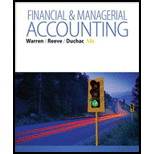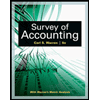
(1)
Profit margin: This ratio gauges the operating profitability by quantifying the amount of income earned from business operations from the sales generated.
Formula of profit margin:
Investment turnover: This ratio gauges the operating efficiency by quantifying the amount of sales generated from the assets invested.
Formula of investment turnover:
Formula of ROI according to Dupont formula:
To determine: Profit margin, investment turnover, and return on investment of E Division
(1)
Explanation of Solution
Determine ROI of E Division, if income from operations is $126,000, sales are $1,575,000, and assets invested are $1,050,000.
(2)
Income statement: The financial statement which reports revenues and expenses from business operations and the result of those operations as net income or net loss for a particular time period is referred to as income statement.
To prepare: The income statements for E Division of Industries G for the year ended December 31, 2016, for each of the three proposals, and compute invested assets for each proposal
(2)
Explanation of Solution
Prepare divisional income statements for E Division of Industries G for the year ended December 31, 2016, for the three proposals.
| Industries G | |||
| Divisional Income Statements | |||
| For the Year Ended December 31, 2016 | |||
| Proposal 1 | Proposal 2 | Proposal 3 | |
| Sales | $1,575,000 | $1,395,000 | $1,575,000 |
| Cost of goods sold | 859,600 | 771,450 | 702,000 |
| Gross profit | 715,400 | 623,550 | 873,000 |
| Operating expenses | 558,000 | 498,000 | 558,000 |
| Income from operations | $157,400 | $125,550 | $315,000 |
Table (1)
Working Notes:
Compute cost of goods sold under proposal 1.
Compute sales under proposal 2.
Compute cost of goods sold under proposal 2.
Compute operating expenses under proposal 2.
Compute cost of goods sold under proposal 3.
(3)
Profit margin, investment turnover, and return on investment of E Division under the three proposals
(3)
Explanation of Solution
Determine ROI of E Division, under proposal 1, if income from operations is $157,400, sales are $1,575,000, and assets invested are $750,000.
Note: Refer to part (1) for the values of income from operations and invested assets.
Determine ROI of E Division, under proposal 2, if income from operations is $125,550, sales are $1,395,000, and assets invested are $937,500.
Note: Refer to part (1) for the values of income from operations, sales, and invested assets.
Determine ROI of E Division, under proposal 3, if income from operations is $315,000, sales are $1,575,000, and assets invested are $1,968,750.
Note: Refer to part (1) for the values of income from operations and invested assets.
(4)
To indicate: The proposal which meets the desired ROI of 20%
(4)
Explanation of Solution
(5)
The increase in investment turnover to meet the desired return of 20%.
(5)
Explanation of Solution
Determine increase in investment turnover of E Division, if income from operations is $126,000 and sales are $1,575,000.
Step 1: Find the required investment turnover to earn desired ROI of 20%.
Step 2: Find the increase in investment turnover, if required investment turnover is 2.5 (From Step 1), and current investment turnover is 1.50 (From Part (1)).
Want to see more full solutions like this?
Chapter 23 Solutions
Financial & Managerial Accounting
- I am looking for help with this financial accounting question using proper accounting standards.arrow_forwardCan you solve this general accounting problem using accurate calculation methods?arrow_forwardI need help finding the accurate solution to this financial accounting problem with valid methods.arrow_forward
- I need help with this general accounting question using standard accounting techniques.arrow_forwardCan you solve this general accounting question with accurate accounting calculations?arrow_forwardI am searching for the correct answer to this general accounting problem with proper accounting rules.arrow_forward
 Managerial AccountingAccountingISBN:9781337912020Author:Carl Warren, Ph.d. Cma William B. TaylerPublisher:South-Western College Pub
Managerial AccountingAccountingISBN:9781337912020Author:Carl Warren, Ph.d. Cma William B. TaylerPublisher:South-Western College Pub Financial And Managerial AccountingAccountingISBN:9781337902663Author:WARREN, Carl S.Publisher:Cengage Learning,
Financial And Managerial AccountingAccountingISBN:9781337902663Author:WARREN, Carl S.Publisher:Cengage Learning, Survey of Accounting (Accounting I)AccountingISBN:9781305961883Author:Carl WarrenPublisher:Cengage Learning
Survey of Accounting (Accounting I)AccountingISBN:9781305961883Author:Carl WarrenPublisher:Cengage Learning


